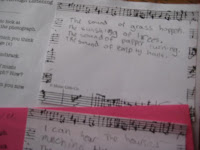
"Find shapes, colours and textures that you like in the exhibition and the building. Use pencils, collage, photography and whatever else you can think of to make an ABSTRACT picture".
The snow and ice were gone and it was a great day to get out of the house, but Bexhill was very, very quiet and so was the Pavilion. The car park outside the De La Warr was free for this pre-Christmas weekend but strangely emptier than usual.
Maybe sensing that they almost had the place to themselves, our compact Lift The Lid group developed an anarchic edge.
Children, of course, take naturally to abstraction (they often just don't know that's a name for it) so I was expecting a smooth ride. Maybe it was some grown ups drawing cartoon figures or quietly doing a little origami, or maybe it was Max's robot that began the shift from making abstract art to throwing paper aeroplanes around the room.
There must be very few people on Earth who have never made and launched a paper aeroplane, it's a universal experience. To do this with children is a lovely reconnection and had the great side effect of making everyone in the room focus on the same thing as watching them fly and commenting on flight style/design/launch technique is irresistible.
Towards the end of the afternoon a gentleman came in who'd been in the RAF in the 1950's. We got into conversation about early jet bombers and abstraction was completely out of the window.
Thanks to everyone for an excellent afternoon. Volunteers were Corin Smith (her last session as part of a Duke of Edinburgh Award) & Ben Wade (who, in a quiet act of resistance to the brief, made an elegantly engineered paper Christmas tree).
Lift The Lid is the De La Warr Pavilion's free drop in session for families on the first Sunday of every month from 2-5pm.















































,+Port+Gibson,+Missisippi+2000.jpg)

